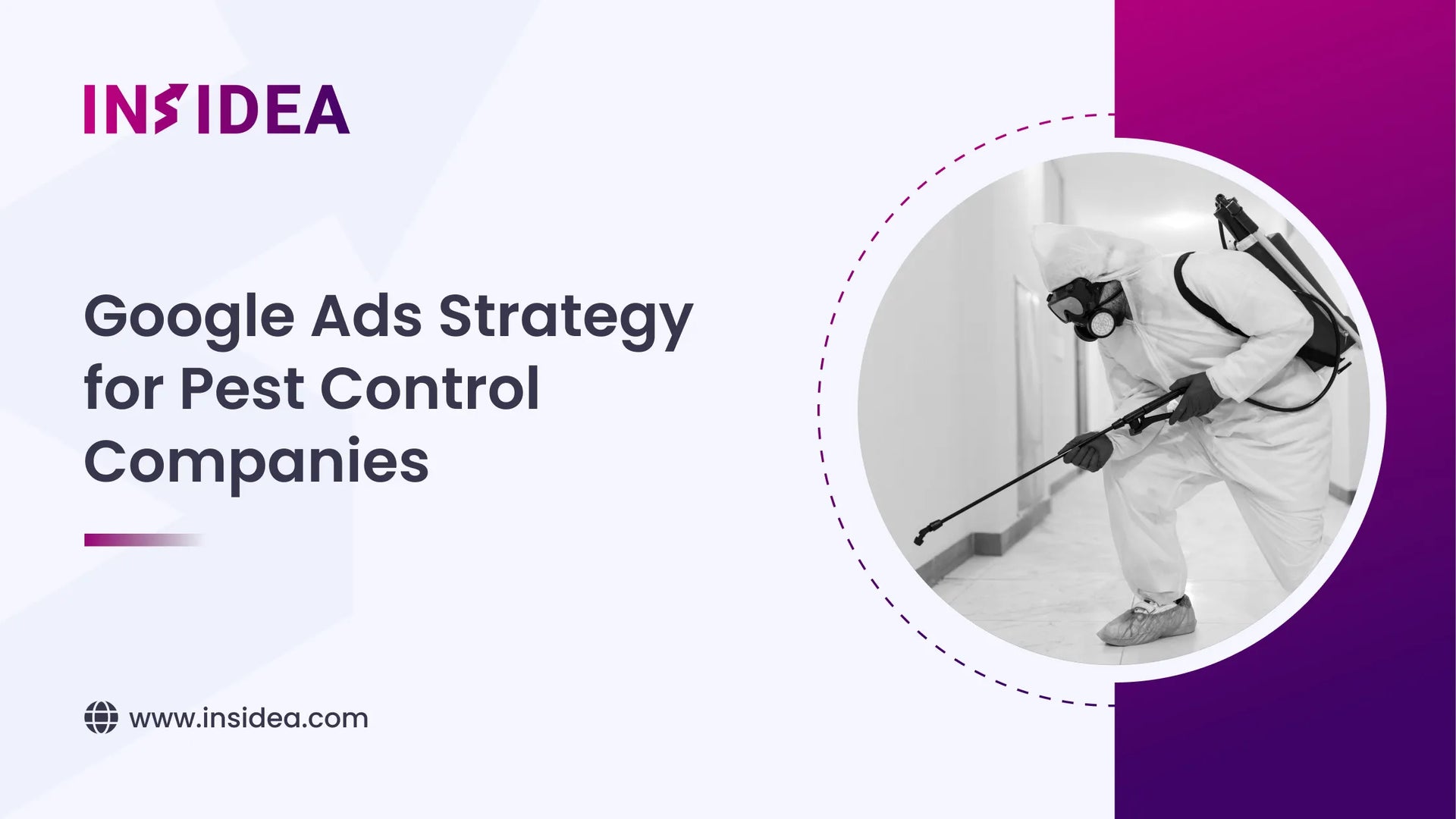
Mastering Google Ads for Pest Control: Strategies for Success
Table of Contents
- Key Highlights:
- Introduction
- The Power of Google Ads for Pest Control Companies
- 11 Google Ads Strategies for Pest Control Companies
- FAQ
Key Highlights:
- Google Ads connects pest control businesses with customers in urgent need, significantly increasing the likelihood of conversions.
- Effective strategies include remarketing, smart bidding, and precise keyword targeting to maximize ad spend and enhance lead generation.
- Utilizing data analytics from Google Ads can optimize campaigns, ensuring pest control companies attract high-intent customers while minimizing wasted budget.
Introduction
In a world where pest control issues can escalate from minor annoyances to major crises, having an effective marketing strategy is essential for pest control businesses. When homeowners encounter a trail of ants or hear scratching in their walls, their immediate response is to seek help. This urgency creates a unique opportunity for pest control companies to connect with potential clients through targeted advertising. Google Ads, with its ability to reach users at the precise moment they are searching for solutions, stands out as an invaluable tool in this regard.
The beauty of Google Ads lies in its capacity to capture the intent of searchers—individuals actively seeking pest control services. Research indicates that a staggering 88% of people who search for local services visit a related business within a day. This statistic highlights the potential for pest control companies to convert searches into bookings if they employ the right strategies. This article details effective Google Ads strategies tailored specifically for pest control companies, providing actionable insights that can lead to increased bookings and a thriving business.
The Power of Google Ads for Pest Control Companies
Google Ads offers pest control companies a unique advantage by connecting them to customers who are in dire need of services. Here are some key reasons why a Google Ads strategy works exceptionally well for this sector:
Captures Urgency at the Right Moment
Google Ads enables businesses to reach customers actively searching for immediate solutions. Phrases such as “exterminator near me” or “same-day pest control” indicate a high level of urgency, positioning pest control businesses to respond to real-time needs.
Targets High-Intent Searches
Unlike traditional advertising that may interrupt users, Google Ads aligns with user intent. This means ads are displayed to individuals who are already looking for pest control services, significantly increasing the chances of conversion.
Reduces Wasted Budget
By focusing on high-intent searches, pest control companies can allocate their advertising budget more effectively, directing it toward qualified leads rather than casual browsers. This strategic allocation maximizes the return on investment for each advertising dollar spent.
Enables Precise Location Targeting
Google Ads allows for granular targeting based on geographic location. Pest control companies can tailor their ads to appear only in specific service areas, enhancing relevance and increasing the likelihood of conversions.
Provides Actionable Performance Data
The analytics provided by Google Ads offer insights into which ads, keywords, and campaigns drive results. This data is invaluable for refining strategies over time, ensuring that pest control companies can adapt and optimize their advertising efforts for better performance.
11 Google Ads Strategies for Pest Control Companies
To harness the power of Google Ads effectively, pest control companies must implement a thoughtful strategy. Below are 11 actionable tactics that can help maximize the effectiveness of Google Ads campaigns.
1. Reconnect with Every Website Visitor and App User
Not every visitor to a pest control website will convert on their first visit. Many may be in the research phase, weighing their options. Remarketing campaigns allow businesses to target individuals who have previously interacted with their website or mobile app. These ads can follow users across other sites, keeping the brand top-of-mind and encouraging them to return.
For instance, if a potential customer visits a page about termite treatments but does not inquire further, a remarketing ad could remind them of their interest: “Think You Might Have Termites? Book Your Free Inspection Today.” Such reminders can be particularly effective in the pest control industry, where urgency can build over time.
To maximize this strategy:
- Segment audiences based on the specific pages they visited.
- Exclude users who have already converted to avoid redundancy.
- Set frequency caps to prevent ad fatigue among viewers.
2. Let Smart Bidding Drive More Bookings
The ultimate goal of pest control ads is to convert clicks into actual bookings. Automated bidding strategies, such as Google’s Smart Bidding, can optimize campaigns for tangible outcomes, such as form submissions, phone calls, or quote requests. Smart Bidding utilizes machine learning to adjust bids in real-time based on the likelihood of conversion.
For example, if a user searches for “emergency pest control near me” late at night, the algorithm recognizes the urgency and can increase your bid to secure a top ad position. Factors taken into account include:
- Device type
- User location
- Time of day
- Previous browsing behavior
This approach allows pest control companies to refine their bidding strategies to maximize bookings without overspending.
3. Target Similar Segments
Identifying and attracting new customers who resemble existing satisfied clients can greatly enhance a pest control business’s marketing efforts. With similar segments targeting, Google Ads can help identify new users whose online behavior mirrors that of previous website visitors or customers.
By utilizing remarketing lists—such as those for customers who booked termite treatment last summer—Google can build a similar audience based on shared characteristics and interests. This means ads can be shown to individuals who are statistically more likely to need pest control services even before they visit the website.
When combined with Smart Bidding and persuasive ad copy, targeting similar segments can effectively fill a pest control company’s appointment schedule with warm leads that are primed to convert.
4. Choose The Right Keywords For Your Copy
A successful Google Ads campaign relies heavily on keyword selection. Rather than bidding on generic terms such as “pest control,” pest control companies should focus on specific, action-driven keywords that indicate a user’s intent to book services.
Targeting long-tail keywords like:
- “emergency termite treatment near me”
- “same-day bed bug exterminator”
- “rodent control service in [city]”
These phrases may attract fewer overall searches, but they connect with those actively looking for immediate services, making each click more valuable.
To refine keyword strategies:
- Emphasize location-specific phrases to attract local customers.
- Include service-based keywords (e.g., “flea removal,” “ant exterminator”).
- Use negative keywords to filter out irrelevant traffic (e.g., DIY solutions or job seekers).
A focused keyword strategy ensures that ad budgets are spent effectively on potential customers who genuinely need pest control services.
5. Use the Budget Report To Make Smart Spending Decisions
In the competitive arena of pest control, inefficient ad spending can quickly drain budgets. Google Ads’ Budget Report provides insights into how daily spending aligns with campaign objectives. This tool helps businesses understand if they are overspending or missing out on opportunities.
For instance, if a pest control company runs ads for termite treatments during peak season, the Budget Report can illustrate how budget adjustments may impact overall performance. By analyzing these visual projections, businesses can make informed decisions about their ad spend, ensuring resources are allocated effectively.
6. Optimize Landing Pages for Conversions
The effectiveness of Google Ads is not solely determined by the ads themselves; the landing pages they direct users to also play a critical role in conversion rates. Optimizing landing pages for user experience and conversion can significantly enhance campaign performance.
Key elements of a conversion-focused landing page include:
- Clear and concise messaging that aligns with the ad.
- Easy-to-navigate layout that highlights key services.
- Prominent call-to-action buttons encouraging users to book appointments or request quotes.
- Trust signals such as customer testimonials, ratings, and industry certifications.
By ensuring that landing pages are optimized for conversions, pest control companies can maximize the effectiveness of their Google Ads campaigns.
7. Implement Ad Extensions for Better Visibility
Ad extensions enhance the visibility and effectiveness of Google Ads by providing additional information to potential customers. These extensions can include:
- Location extensions, showing the business address and distance to the user.
- Call extensions, allowing users to call the business directly from the ad.
- Sitelink extensions, featuring links to specific services or special offers.
Utilizing ad extensions allows pest control companies to present more information and options to users, increasing the likelihood of engagement and conversion.
8. Monitor and Adjust Ad Performance Regularly
A successful Google Ads strategy is not a set-it-and-forget-it endeavor. Regular monitoring and adjustment of ad performance are crucial for maintaining effectiveness. By analyzing metrics such as click-through rates (CTR), conversion rates, and cost per acquisition (CPA), pest control companies can identify trends and make data-driven adjustments.
Setting up regular performance reviews can help businesses spot underperforming ads, keywords, or campaigns. This proactive approach allows for timely optimization, ensuring that advertising efforts remain aligned with business goals.
9. Test Different Ad Formats
Google Ads offers various ad formats, including text ads, display ads, and video ads. Experimenting with different formats can help pest control companies find the most effective methods for reaching their target audience.
For example, video ads showcasing a pest control service in action or testimonials from satisfied customers can create a more engaging experience for viewers. A/B testing different ad formats can provide insights into which styles resonate most with potential clients.
10. Leverage Seasonal Trends
Pest control needs can vary significantly throughout the year, influenced by seasonal trends. Understanding these patterns allows companies to tailor their advertising efforts accordingly. For example, spring and summer months may see increased demand for ant and termite treatments, while fall may focus on rodent control.
By adjusting ad messaging and budget allocation based on seasonal trends, pest control companies can seize opportunities when demand is at its peak.
11. Utilize Customer Reviews and Testimonials
In the pest control industry, trust is paramount. Customer reviews and testimonials can serve as powerful tools to enhance credibility and attract new clients. Incorporating positive customer feedback into ad copy or landing pages can help establish trust and encourage potential customers to choose your services.
Encouraging satisfied customers to leave reviews on platforms such as Google My Business can also improve local search visibility, further enhancing the effectiveness of Google Ads campaigns.
FAQ
How quickly can I expect results from Google Ads for my pest control business?
Results can vary based on factors such as competition, budget, and campaign strategy. However, many pest control companies start seeing leads within days of launching their campaigns if they implement effective targeting and ad strategies.
How do I measure the success of my Google Ads campaigns?
Key performance indicators (KPIs) to monitor include click-through rates (CTR), conversion rates, cost per acquisition (CPA), and return on ad spend (ROAS). Google Ads provides comprehensive analytics tools to help assess performance.
What is the difference between Google Ads and SEO for pest control companies?
Google Ads provides immediate visibility and traffic through paid advertising, while SEO focuses on organic search rankings and takes time to build. Both strategies can be complementary, with Google Ads offering quick results and SEO fostering long-term growth.
Can I run Google Ads without a website?
While having a website is highly recommended for landing potential customers and providing information about services, it is possible to run ads that direct users to call the business or engage through other platforms. However, a website enhances credibility and conversion opportunities.
How can I reduce wasted ad spend in my Google Ads campaigns?
Implementing strategies such as precise keyword targeting, utilizing negative keywords, and leveraging location targeting can minimize wasted ad spend. Regular monitoring and adjustments based on performance data also help maximize budget efficiency.
By adopting these strategies, pest control companies can effectively harness the power of Google Ads, ensuring they are well-positioned to meet the needs of customers in urgent situations. As businesses refine their advertising approaches and leverage data analytics, they will not only fill their schedules with high-value jobs but also cultivate lasting relationships with satisfied customers.
POWER your ecommerce with our weekly insights and updates!
Stay aligned on what's happening in the commerce world
Email Address
Handpicked for You

08 September 2025 / Blog
How to Avoid Greenwashing: Rules, Real-World Examples, and a Practical Playbook for Honest Environmental Claims
Read more
08 September 2025 / Blog
Klaviyo 2025: How its AI-Driven CRM Transforms Shopify Email Marketing and the Customer Experience
Read more
08 September 2025 / Blog


